Abstract—
Ultrastructural studies were carried out on wild Kenyan sandflies (Phlebotomus pedifer) naturally infected with Leishmania aethiopica. The promastigotes were attached to structures resembling pieces of a peritrophic membrane. They were located amongst long microvilli and also deep in the cytoplasm of the gut cells. The factors which influence the invasion of the parasites into cells are not known and need to be investigated.
Similar content being viewed by others
References
Frevogel T. A. (1975) Blood digesion in haematophagous insects. Acta trop. 32, 81–124.
Heisch R. B. (1954) Studies in leishmaniasis in East Africa. I. The epidemiology of an outbreak of kala-azar in East Africa. Trans. R. soc. trop. Med. Hyg. 48, 449–464.
Heisch B. R. (1955) The vector of an outbreak of kala-azar in Kenya. Nature, Land. 175, 443.
Heisch R. B., Wijers D. J. B. and, Minter D. M. (1962) In pursuit of the vector of kala-azar in Kenya. Br. med. J. 1, 1456–1458.
Killick-Kendrick R. (1979) Biology of Leishmania in phlebotomine sandflies. In Biology of the Kinetoplastids (Ed. by Lumsden W. H. R. and Evans D. A.), Vol. 2. Academic Press, London.
Killick-Kendrick R.,, Molyneux D. H. and Ashford R. W. (1974) Leishmania in phlebotomid sandflies, 1. Modification of the flagellum associated with attachment of the midgut and oesophageal value of the sandfly. Proc. R. Soc. B 187, 409–419.
Minter D. M. and Wijers D. J. B. (1963) Studies on the vectors of kala-azar in Kenya. IV. Experimental evidence. Ann. trop. Med. Parasit. 57, 24–31.
Minter D. M., Wijers D. J. B., Heisch R. B. and, Manson-Bahr P. E. C. (1962) Phlebotomus martini—a probable vector of kala-azar in Kenya. Br. med. J. 11, 835.
Molyneux D. H., Killick-Kendrick R. and Ashford R. W. (1975) Leishmania in phlebotomine sandflies. III. The ultrastructure of Leishmania mexicana amazonensis in the midgut and pharynx of Lutzomyia lonyipalpis. Proc. R. Soc. B 190, 341–357.
Mutinga M. J. (1971) Phlebotomus longipes a vector of cutaneous leishmaniasis in Kenya. Trans. R. Soc. trop. Med. Hyg. 65, 106.
Mutinga M. J. and Ngoka J. M. (1978) Incrimination of the vector of visceral leishmaniasis in Kenya. E. Afr. med. J. 55, 337–340.
Peters W.,, Mutinga M. J. and Ngoka J. M. (1977) The identification of human and animal isolates of Leishmania from Kenya. Ann. trop. Med. Parasit. 71, 501–502.
Reynold E. S. (1963) The use of lead citrate at high pH as an electron opaque stain in electron microscopy. J. Cell Biol. 17, 208–212.
Weakley B. S. (1972) A Beginners Handbook in Biological Electron Microscopy. Churchill Livingstone, Edinburgh.
Wijers D. J. B. and, Minter D. M. (1962) Studies on the vector of kala-azar in Kenya. 1. Entomological evidence. Ann. trop. Med. Parasit. 56, 462–472.
Author information
Authors and Affiliations
Rights and permissions
About this article
Cite this article
Kaddu, J.B., Mutinga, M.J. Leishmania in Kenyan Phlebotomine Sandflies—I. Leishmania Aethiopica in the Midgut of Naturally Infected Phlebotomus Pedifer. Int J Trop Insect Sci 2, 245–250 (1981). https://doi.org/10.1017/S1742758400001120
Received:
Published:
Issue Date:
DOI: https://doi.org/10.1017/S1742758400001120




